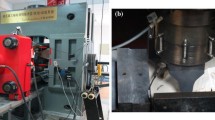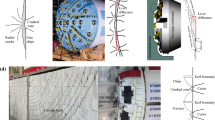Abstract
To clarify some aspects of rock destruction with a disc acting on a high confined tunnel face, a series of tests were carried out to examine fracture mechanisms under an indenter that simulates the tunnel boring machine (TBM) tool action, in the presence of an adjacent groove, when a state of stress (lateral confinement) is imposed on a rock sample. These tests proved the importance of carefully establishing the optimal distance of grooves produced by discs acting on a confined surface, and the value (as a mere order of magnitude) of the increase of the thrust to produce the initiation of chip formation, as long as the confinement pressure becomes greater.
Similar content being viewed by others
References
R. Cordel, G. Comes, P. Duffaut, A. Valantin, M. Coder, and R. Perami, La géotechnique et le creusement mécanisé des tunnels, Institut Technique Du Batiment et des Travaux Publics, 1974.
P.J. Tarkoy and M. Marconi, Difficult rock comminution and associated geological conditions, [in] Proceeding of the 6th Congress on Tunnelling, London, 1991, p.195.
K. Gehring, Design criteria for TBM’s with respect to real rock response, [in] Proceeding of Tunnel Boring Machines: Trends in Design and Construction of Mechanised Tunnelling, Linz, 1995, p.43.
S. Klein, M. Schmoll, and T. Avrey, TBM performance at four hard rock tunnels in California, [in] Proceedings of the Rapid Excavation Tunnel Conference, S. Francisco, 1995, p.61.
N. Innaurato and P.P. Oreste, L’interazione roccia-utensile nelle macchine di scavo per roccia, [in] Atti dell’VIII Ciclo di Conferenze di Meccanica ed Ingegneria delle Rocce, Torino, 2000, p.111.
N. Innaurato and P. Oreste, Theoretical approach for assessment of the mechanics of rock failure in the TBMs tools-rock interaction, [in] Proceedings of the AITES-ITA World Tunnel Congress, Milan, 2001, p.227.
N. Barton, TBM Tunnelling in Jointed and Faulted Rock, Balkema, Rotterdam, 2000, p.177.
T. Movinkel and O. Johannesen, Geological parameters for hard rock tunnel boring, Tunnels Tunnelling Int., 18(1986), No.4, p.45.
H.L. Hartman, Basic studies of percussion drilling, Min. Eng., 11(1959), p.68.
W.C. Maurer, The state of rock mechanics knowledge in drilling, [in]_Proceedings of the 8th Symposium on Rock Mechanics, University of Minnesota, 1966, p.355.
Y. Nishimatsu, The mechanics of rock cutting, Int. J. Rock Mech. Min. Sci. Geomech. Abstr., 9(1972), p.261.
Fourmaintraux, Machines foreuses pour tunnels et galeries, Techniques et bases théoriques de l’abattage mécanique des roches, Rapport de recherche N.20 L.C.P.C., 1972.
F. Gaye, Efficient excavation with particular reference to cutting head design of hard rock tunnelling machines, Tunnels Tunnelling, 4(1972), p.39; p.135; p.249.
Itasca Consulting Group. FLAC3D User’s Manual, ICG, Minnesota, 1996.
Author information
Authors and Affiliations
Corresponding author
Rights and permissions
About this article
Cite this article
Innaurato, N., Oggeri, C., Oreste, P. et al. Laboratory tests to study the influence of rock stress confinement on the performances of TBM discs in tunnels. Int J Miner Metall Mater 18, 253–259 (2011). https://doi.org/10.1007/s12613-011-0431-z
Received:
Revised:
Accepted:
Published:
Issue Date:
DOI: https://doi.org/10.1007/s12613-011-0431-z




